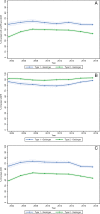Obesity and Chronic Kidney Disease in US Adults With Type 1 and Type 2 Diabetes Mellitus
- PMID: 35080610
- PMCID: PMC9016431
- DOI: 10.1210/clinem/dgab927
Obesity and Chronic Kidney Disease in US Adults With Type 1 and Type 2 Diabetes Mellitus
Abstract
Objective: Obesity is a global public health challenge and strongly associated with type 2 diabetes (T2D), but its burden and effects are not well understood in people with type 1 diabetes (T1D). Particularly, the link between obesity and chronic kidney disease (CKD) in T1D is poorly characterized.
Research design and methods: We included all T1D and, for comparison, T2D in the Geisinger Health System from 2004 to 2018. We evaluated trends in obesity (body mass index ≥ 30 kg/m2), low estimated glomerular filtration rate (eGFR) (≤60 mL/min/1.73m2), and albuminuria (urine albumin-to-creatinine ratio ≥ 30 mg/g). We used multivariable logistic regression to evaluate the independent association of obesity with CKD in 2018.
Results: People with T1D were younger than T2D (median age 39 vs 62 years). Obesity increased in T1D over time (32.6% in 2004 to 36.8% in 2018), while obesity in T2D was stable at ~60%. The crude prevalence of low eGFR was higher in T2D than in T1D in all years (eg, 30.6% vs 16.1% in 2018), but after adjusting for age differences, prevalence was higher in T1D than T2D in all years (eg, 16.2% vs 9.3% in 2018). Obesity was associated with increased odds of low eGFR in T1D [adjusted odds ratio (AOR) = 1.52, 95% CI 1.12-2.08] and T2D (AOR = 1.29, 95% CI 1.23-1.35).
Conclusions: Obesity is increasing in people with T1D and is associated with increased risk of CKD. After accounting for age, the burden of CKD in T1D exceeded the burden in T2D, suggesting the need for increased vigilance and assessment of kidney-protective medications in T1D.
Keywords: aging; epidemiology; nephropathy; obesity; type 1 diabetes; type 2 diabetes.
© The Author(s) 2022. Published by Oxford University Press on behalf of the Endocrine Society. All rights reserved. For permissions, please e-mail: journals.permissions@oup.com.
Figures






References
Publication types
MeSH terms
Grants and funding
LinkOut - more resources
Full Text Sources
Medical
Research Materials
Miscellaneous

